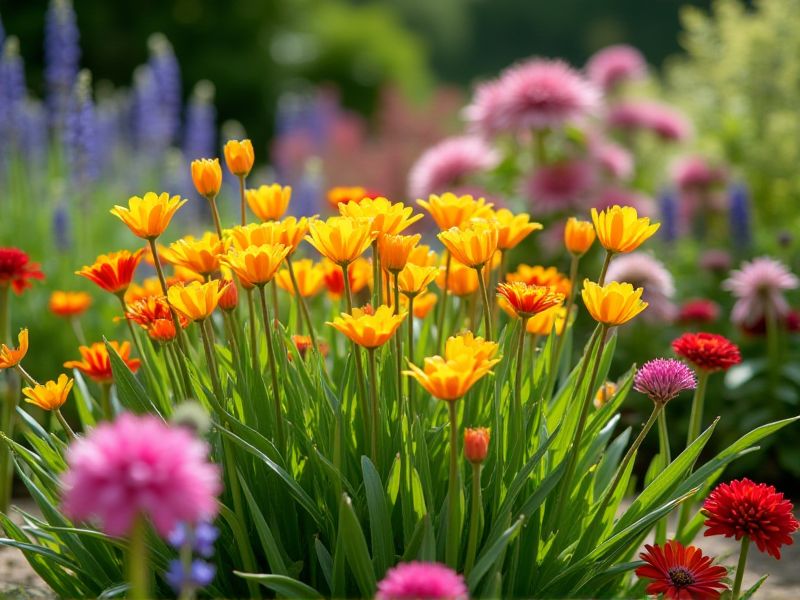
Succulents, such as aloe vera and jade plants, thrive in arid environments and require minimal water, making them ideal for water-conscious gardeners. Ornamental grasses, like blue fescue and fountain grass, not only add vibrant colors but also adapt well to dry conditions. Certain varieties of sedum, particularly ground covers like sedum dragons blood, bring color while needing little to no irrigation. Native desert plants, including desert marigolds and agave, can enhance your garden's visual appeal while conserving water resources. By incorporating these drought-tolerant species, you can create a lush, sustainable landscape that flourishes with minimal environmental impact.
List of some Colorful plants that require low water
- Bougainvillea (Bougainvillea spp.)
- Red Yucca (Hesperaloe parviflora)
- Blanket Flower (Gaillardia spp.)
- Portulaca (Portulaca grandiflora)
- Lantana (Lantana camara)
- California Poppy (Eschscholzia californica)
- Verbena (Verbena spp.)
- Desert Marigold (Baileya multiradiata)
- Russian Sage (Perovskia atriplicifolia)
- Oleander (Nerium oleander)
Important things about Colorful plants that require low water
Succulents
Succulents are vibrant, hardy plants known for their ability to thrive in low-water environments, making them ideal for drought-prone areas or busy lifestyles. These colorful plants store water in their thick, fleshy leaves, ensuring they maintain their striking appearance without frequent watering. Varieties such as Echeveria, Sedum, and Aloe not only add a splash of color to your home or garden but also require minimal care, allowing you to enjoy their beauty without much effort. Incorporating succulents into your space can enhance its aesthetic while promoting water conservation.
Cacti
Cacti are vibrant, drought-tolerant plants that thrive in arid environments, making them ideal for low-water gardens. With a stunning array of colors ranging from bright pinks to deep greens, these succulent species add visual interest to any landscape. You can find various cacti, including the popular Saguaro and Easter Cactus, which not only require minimal watering but also offer unique shapes and textures. Incorporating cacti into your garden not only enhances its aesthetic appeal but also promotes sustainability by conserving water resources.
Lavender
Lavender, known for its stunning purple hues and aromatic properties, is an excellent choice for colorful gardens that require minimal water. This drought-tolerant plant thrives in sunny environments and well-drained soil, making it perfect for xeriscaping. You can enjoy its striking blossoms from late spring to early summer, attracting pollinators like bees and butterflies. With its low maintenance needs and resilient nature, lavender adds beauty and fragrance to your outdoor space without excessive water usage.
Sedum
Sedum, commonly known as stonecrop, is a vibrant succulent that thrives in dry conditions, making it ideal for low-water gardens. These colorful plants display a range of hues from deep greens to bright pinks and yellows, adding visual interest to any landscape. With a minimal need for irrigation, Sedum can flourish in poor soil, attracting pollinators like bees and butterflies. You can easily incorporate various Sedum species into rock gardens, containers, or as ground cover to create a stunning, drought-resistant environment.
Lantana
Lantana, known for its vibrant clusters of flowers in shades of yellow, orange, pink, and purple, thrives in low-water conditions, making it an ideal choice for drought-resistant gardens. This perennial plant attracts pollinators like butterflies and bees, contributing to a healthy ecosystem in your outdoor space. With its ability to tolerate poor soil and heat, Lantana is perfect for xeriscaping, reducing the need for excessive irrigation. Regular pruning encourages bushier growth and enhances its colorful display, ensuring your garden remains lively and inviting throughout the growing season.
Gaillardia
Gaillardia, commonly known as blanket flowers, are vibrant, drought-tolerant plants that thrive in low-water gardens. These perennials feature striking flowers in shades of red, orange, and yellow, attracting pollinators such as bees and butterflies. With their robust nature, Gaillardia can flourish in various soils, making them an excellent choice for xeriscaping and sustainable landscaping. Incorporating Gaillardia into your garden not only adds color and beauty but also promotes water conservation and ecological health.
Ornamental Grasses
Ornamental grasses are an excellent choice for gardens where water conservation is a priority, as many varieties thrive with minimal irrigation. Species such as Pennisetum alopecuroides and Miscanthus sinensis not only add texture but also bring vibrant colors ranging from soft greens to striking whites and purples throughout the growing season. These hardy plants typically require well-drained soil and sunlight, making them a versatile option for various landscapes. Incorporating ornamental grasses into your garden can enhance its aesthetic appeal while supporting sustainable gardening practices.
Yucca
Yucca plants are remarkable for their vibrant foliage and minimal water requirements, making them an excellent choice for arid gardens or low-maintenance landscapes. These drought-tolerant perennials display striking architectural forms, with long, sword-like leaves that can be green, blue, or variegated, depending on the species. When fully mature, yuccas produce stunning clusters of creamy white or yellow flowers, adding a dramatic burst of color to your outdoor space. Incorporating yucca into your garden not only conserves water but also enhances the visual appeal with its unique textures and shapes.
Echinacea
Echinacea, commonly known as coneflower, is a vibrant, drought-resistant plant ideal for low-water gardens. These perennial flowers, characterized by their daisy-like blooms in shades of pink, purple, and white, attract pollinators such as bees and butterflies, enhancing garden biodiversity. Echinacea thrives in well-drained soil and full sun, making it a low-maintenance choice for gardeners seeking both beauty and sustainability. By incorporating Echinacea into your landscape, you can enjoy colorful displays with minimal water requirements, promoting eco-friendly gardening practices.
Rosemary
Rosemary (Rosmarinus officinalis) thrives in arid conditions, making it an excellent choice for gardens prioritizing low-water plants. This Mediterranean herb features needle-like leaves that are not only aromatic but also vibrant green, adding a splash of color and texture to your landscape. Pairing well with other drought-resistant species, such as succulents or lavender, rosemary creates a visually appealing and sustainable garden design. Opting for plants like rosemary can significantly reduce your water usage while still providing a colorful, lush appearance.
